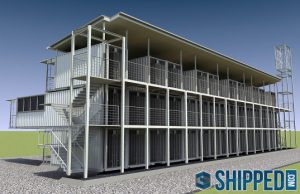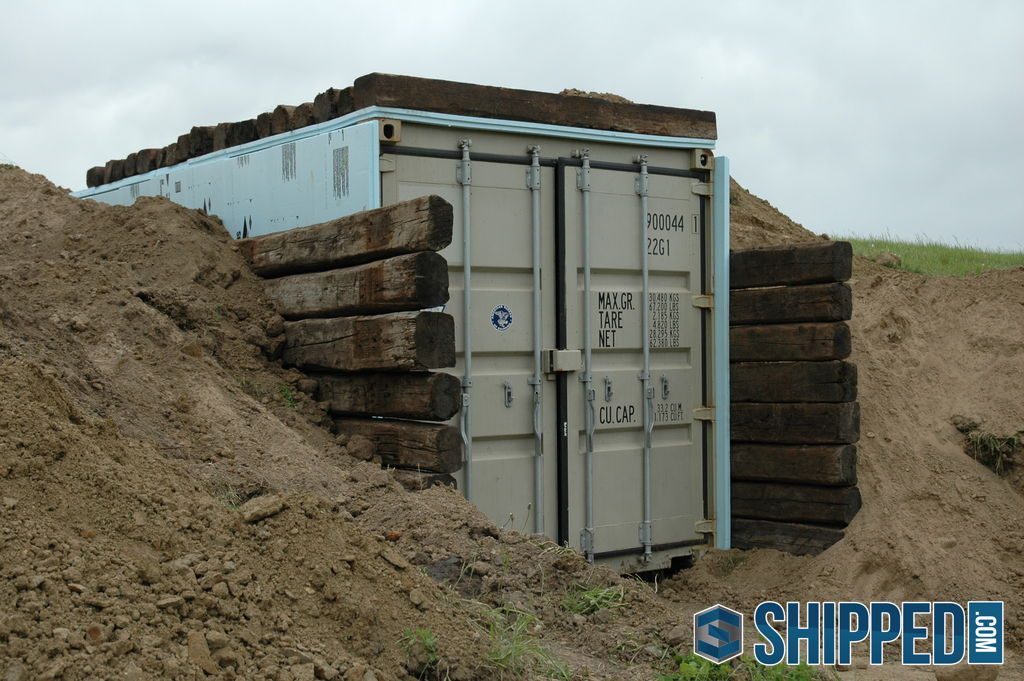Shipping Container Emergency Shelters
September 14, 2018 saw Hurricane Florence cause catastrophic damage to the Carolinas as 150Km/h winds lashed the two states. Many people consider the purchase of a shipping container in the aftermath of a storm when their homes have suffered roof damage, but with some planning shipping containers can also be built into emergency shelters to save lives while a storm is passing. We’ve seen shipping containers turned into so many different kinds of structures in recent times. Tiny homes, container hotels, swimming pools, fallout shelters, retail stores, mobile restaurants, you name it someone has done it with a conex box!
Over recent years the humble shipping container has become an integral part of disaster management, as temporary accomodation, hospitals or ablution blocks or other facilities required in an emergency situation. They are made to be strong and easily transportable. So its logical that these would be used as storm shelters. For those living in regions prone to hurricanes and tropical storms, you might want to consider a shipping container as your storm shelter. Shipping containers were made to withstand harsh weather conditions on long sea voyages, wind, rain, snow and ice, so its logical that they would make a good shelter. They can easily withstand up to 150mph winds. Many typhoon and hurricane prone communities are turning more and more towards the shipping container as a sturdy and inexpensive way to ensure they are protected during extreme weather.
 With the increasing popularity of the construction of hidden bunkers and fallout shelters an abundance of information can be found online regarding designs that utilise buried or partially buried conex containers, but this can come with its own problems. This is because containers are designed to be stacked and can bear weight on the corner posts (corner castings) but are not designed to withstand pressure from the sides (ie. The weight of the earth the conex container is buried in). Whether to bury or not is probably your biggest and most important consideration. An underground shipping container shelter comes with the obvious advantage of being out of the range of where a tornado will hit, since the most damage is done 10 foot from the ground, but in order to do this the sides must be reinforced prior to it being buried, or you may find the container walls being crushed.
With the increasing popularity of the construction of hidden bunkers and fallout shelters an abundance of information can be found online regarding designs that utilise buried or partially buried conex containers, but this can come with its own problems. This is because containers are designed to be stacked and can bear weight on the corner posts (corner castings) but are not designed to withstand pressure from the sides (ie. The weight of the earth the conex container is buried in). Whether to bury or not is probably your biggest and most important consideration. An underground shipping container shelter comes with the obvious advantage of being out of the range of where a tornado will hit, since the most damage is done 10 foot from the ground, but in order to do this the sides must be reinforced prior to it being buried, or you may find the container walls being crushed.
If you do choose to bury your shipping container, there are many steps to consider. You should know inside and out the anatomy of your container. Most shipping containers are built from Corten steel, also called ‘weathering’ steel. It is a very rust resistant strong steel alloy, combined with a rust resistant paint designed to hold up against extreme weather during ocean travel. If the paint is damaged the exposed area should develop a thick oxide film preventing it from rusting any further. The doors should seal to be wind and water tight making sure they can effectively contain the cargo inside. A 20ft container weighs around 5000 lbs and is designed to carry up to 60.000 lbs of cargo whilst being stacked up to 9 containers high. You would think this sturdy structure should then be able to stand the weight of a few cubic feet of earth, right? Unfortunately it’s not that simple. The strength in a container is found in its frame. Imagine the soda can as an analogy. An unopened can and hold the weight of a grown man standing on top of it, or the weight of several more unopened cans stacked on top. But if you were to push on the side of one of the cans, it would take very little pressure to topple the stack. Similarly if you used a damaged can with a dent in the side, the result would be the same.
So above ground containers are now also an option, with many companies offering modifications on their containers to make the intermodal shipping container an easily transportable option. However it must be remembered that considerable alterations must be done in order to make the container storm or tornado proof and that it would not be enough to simply take shelter in a container. A British couple were almost killed on the Falkland Islands when, in the middle of nowhere and out of options, they chose the steel structure to take cover in when the container was lifted and thrown 200m across the ground.
There are many real life examples of shipping containers standing up to harsh weather. After Hurricane Sandy, the worst  of the 2012 Atlantic season, New York decided to plan for future disasters by coming up with emergency storm shelter housing options to accommodate those who would be forced from their homes by such an event. Their proposal came up with a better more private alternative than housing people in gymnasiums and community centers – multiple shipping containers stacked four high and twelve wide. There is also the Seed Project in Haiti, which utilizes the large number of unused shipping containers due to the number of imports outweighing the exports in the Carribean, as emergency disaster housing for the homeless.
of the 2012 Atlantic season, New York decided to plan for future disasters by coming up with emergency storm shelter housing options to accommodate those who would be forced from their homes by such an event. Their proposal came up with a better more private alternative than housing people in gymnasiums and community centers – multiple shipping containers stacked four high and twelve wide. There is also the Seed Project in Haiti, which utilizes the large number of unused shipping containers due to the number of imports outweighing the exports in the Carribean, as emergency disaster housing for the homeless.
Whatever design you choose to go with for your shipping container storm shelter, the most important thing you should have in common with these real life projects is adequate planning, which should have input from those qualified to get the job done. If thats not you, get outside help. After all, the point of this shelter is safety, and you want to make sure you have the resources and information available to plan the safest most effective shipping container bunker possible for the protection of both you and your family.
Here’s a video showing the construction of an underground shipping container storm shelter:
If you would like to read more about how to plan for your shipping container delivery you can view our container delivery guidelines by clicking here: CONTAINER DELIVERY GUIDELINES
Are you interested in buying a new or used shipping container at the lowest possible price along with the best delivery terms available? Shipped.com saves you real time and money, enabling you to see instant pricing, including delivery and checkout safely all online! See Container Deals Now…






Recent Comments